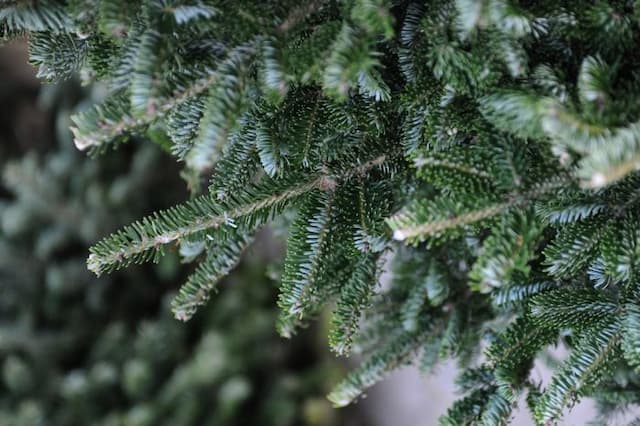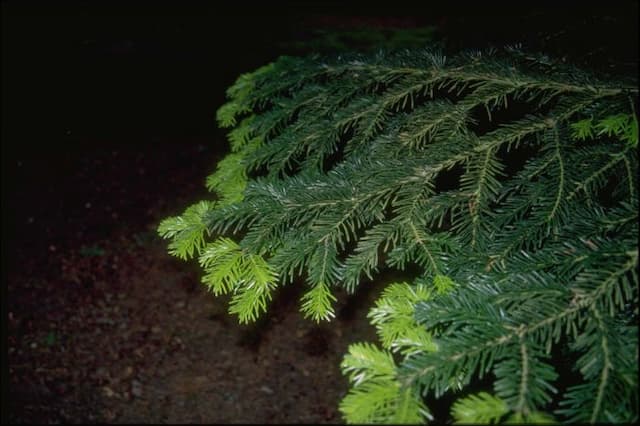Likiang spruce Picea likiangensis

ABOUT
The Lijiang spruce is a coniferous evergreen tree known for its pyramidal shape and dense branching. The foliage of this species is comprised of needle-like leaves, which are arranged spirally on the branches and have a distinctive glossy dark green color. The needles are short, rigid, and have a sharp tip, exhibiting a uniform appearance that contributes to the plant's overall lush, textured look. The bark of Lijiang spruce is another notable feature; it is typically gray-brown and becomes rugged and furrowed as the tree matures. During the spring, this spruce produces small, inconspicuous flowers, which are followed by the development of cones. The cones are pendulous, elongated, and cylindrical in shape, initially displaying a green hue that matures into a woody brown as they age and release seeds. Overall, the Lijiang spruce is an attractive conifer, appreciated for its symmetrical form and evergreen foliage that adds a touch of greenery to landscapes throughout the seasons.
About this plant
 Names
NamesFamily
Pinaceae.
Synonyms
Likiang Spruce, Yulongxueshan Spruce.
Common names
Picea likiangensis var. linzhiensis, Picea likiangensis var. montigena, Picea purpurea, Picea rubescens.
 Toxicity
ToxicityTo humans
The Likiang spruce (Picea likiangensis) does not have a well-documented profile of toxicity to humans. However, most species in the genus Picea are not known to be poisonous. While some people might be sensitive to the oils or sap, leading to skin irritation or allergic reactions, ingestion of the plant parts is not typically associated with severe poisoning. Nonetheless, non-edible plants can sometimes cause discomfort, indigestion, or other mild gastrointestinal upset if ingested. It's always a good practice to avoid eating parts of ornamental plants due to the potential for unspecified toxins.
To pets
The Likiang spruce (Picea likiangensis) is not commonly listed as a toxic plant to pets. Spruce trees, in general, are not known for being poisonous to dogs or cats. However, ingestion of needles can potentially cause gastrointestinal upset, such as vomiting or diarrhea, due to mechanical irritation. If a pet ingests a large amount of plant material, obstruction is a risk, particularly with smaller pets. While the toxicity is low, it is advisable to prevent pets from chewing on or ingesting parts of the tree.
 Characteristics
CharacteristicsLife cycle
Perennials
Foliage type
Evergreen
Color of leaves
Green
Height
60 feet [18 meters]
Spread
15 feet [4.5 meters]
Plant type
Tree
Hardiness zones
4
Native area
China
Benefits
 General Benefits
General Benefits- Ecosystem support: Picea likiangensis, commonly known as Lijiang spruce, provides habitat for various wildlife species, including birds and small mammals which may use the tree for shelter or nesting.
- Aesthetic value: With its attractive conical shape and evergreen foliage, it is frequently used in landscaping and garden designs for visual appeal.
- Soil stabilization: The tree's extensive root system helps prevent erosion by stabilizing the soil, making it beneficial for planting in areas prone to landslides or soil degradation.
- Climate and water regulation: Lijiang spruce trees play a role in climate moderation by shading areas and reducing temperature extremes. Its presence can also contribute to water regulation in the environment.
- Carbon sequestration: As a large tree, it is capable of absorbing significant amounts of carbon dioxide from the atmosphere, helping to mitigate the effects of climate change.
- Wood resource: Lijiang spruce provides timber that can be used for construction, furniture-making, and other purposes where wood is required.
- Cultural significance: In certain areas, this species may hold cultural or symbolic importance and can be featured in parks and memorial gardens.
 Medical Properties
Medical PropertiesThis plant is not used for medical purposes.
 Air-purifying Qualities
Air-purifying QualitiesThis plant is not specifically known for air purifying qualities.
 Other Uses
Other Uses- Instrument Craftsmanship: The wood of the Lijiang spruce is sometimes used in the construction of musical instruments for its acoustic properties.
- Festive Decorations: In some regions, Lijiang spruce is utilized as a Christmas tree due to its pyramidal shape and evergreen nature.
- Erosion Control: This spruce species can be planted on slopes and hilly areas to prevent soil erosion due to its extensive root system.
- Windbreaks: The dense foliage and the height of Lijiang spruce trees make them suitable for creating protective windbreaks around properties.
- Habitat Support: Lijiang spruce provides habitat and protection for a variety of wildlife, including birds and small mammals within its range.
- Ornamental Use: Due to its attractive form and foliage, Lijiang spruce is planted for aesthetic purposes in gardens and parks.
- Privacy Screening: Its dense growth can be exploited to form living privacy screens between properties.
- Silviculture: It may be used in forest management and cultivation practices for its value as a timber species.
- Cultural Significance: In some cultures, parts of the Lijiang spruce may be used in traditional ceremonies or as symbols of particular virtues or attributes.
- Wood Carving: The wood of Lijiang spruce is used for carving artisanal objects and decorative items due to its workability.
Interesting Facts
 Feng Shui
Feng ShuiThe plant Picea likiangensis, also known as Lijiang spruce, is not used in Feng Shui practice.
 Zodiac Sign Compitability
Zodiac Sign CompitabilityThe Lijiang spruce is not used in astrology practice.
 Plant Symbolism
Plant Symbolism- Endurance and Resilience: Picea likiangensis, commonly known as the Lijiang spruce, can thrive in harsh mountainous environments, symbolizing the ability to endure and remain steadfast in the face of adversity.
- Longevity: Spruces in general are known for their long life spans, with the Lijiang spruce representing longevity and the wisdom that comes with age.
- Protection: The evergreen nature of the spruce implies constancy and protection, as it remains green throughout the year, suggesting an unwavering source of shelter.
- Nature's Majesty: The majestic growth and imposing stature of the Lijiang spruce is often seen as a symbol of the awe-inspiring beauty and power of the natural world.
- Purity: The spruce's association with mountainous regions and its evergreen quality can symbolize purity and cleansing, representing a connection to the pristine and untainted aspects of nature.
 Water
WaterThe Lijiang spruce should be watered regularly, aiming for a deep watering to encourage a strong root system. Depending on weather conditions, water deeply once or twice a week, providing approximately 1 to 2 gallons per watering session. During the growing season in spring and summer, it's crucial to maintain consistent moisture, but allow the soil to dry out slightly between waterings to prevent root rot. Reduce the frequency of watering in the fall and further in winter when the tree goes dormant and requires less water.
 Light
LightThe Lijiang spruce thrives best in full sun exposures, where it can receive at least 6 hours of direct sunlight daily. It's important to place it in a location free from shade from buildings or other trees to ensure it gets the light it needs for healthy growth. Partial shade can be tolerated, but full sun will result in the most robust growth and form.
 Temperature
TemperatureThe Lijiang spruce can withstand a wide range of temperatures and is hardy in USDA zones 4 through 7. It can survive temperatures as low as -30°F and can tolerate summer highs up to around 80°F. For optimal growth, this spruce prefers cooler mountain climates where temperatures typically range between 40°F and 70°F during the growing season.
 Pruning
PruningPruning the Lijiang spruce is usually done for shaping and to remove any dead or damaged branches, thereby maintaining its appearance and health. The best time to prune is in late winter or early spring before new growth starts. Annually inspect the tree and prune as needed, always using clean, sharp tools to make precise cuts.
 Cleaning
CleaningNot needed
 Soil
SoilThe Lijiang spruce prefers a well-draining soil mix, typically composed of one part peat, one part pine bark, and one part coarse sand or perlite. The ideal soil pH for Lijiang spruce is slightly acidic to neutral, ranging from 5.5 to 7.0.
 Repotting
RepottingLijiang spruces, being slow-growing conifers, do not need frequent repotting; every 3-4 years is sufficient. It's best to repot in the late winter or early spring before new growth begins.
 Humidity & Misting
Humidity & MistingLijiang spruce prefers moderate to high humidity levels but can tolerate lower humidity environments. It is best to aim for a humidity level of around 40-60%.
 Suitable locations
Suitable locationsIndoor
Use bright, indirect light and cool temps for Lijiang spruce indoors.
Outdoor
Ensure full sun, shelter from wind, and good drainage for Lijiang spruce.
Hardiness zone
3-7 USDA
 Life cycle
Life cycleThe Lijiang spruce (Picea likiangensis) begins its life cycle as a seed, typically nestled in a cone and dispersed by wind or wildlife. Once the seed lands in a suitable environment, it undergoes germination and a seedling emerges, establishing roots and a single shoot. As the young spruce grows, it enters the sapling stage, developing a distinct conical shape and needle-like leaves adaptive to its mountainous habitats. Maturing into an adult tree, the Lijiang spruce may reach substantial heights and can start producing cones after 15-40 years, depending on environmental conditions. Adult trees are characterized by periodic growth of new shoots, needles, and cones, with the latter containing seeds that perpetuate the species. Eventually, the Lijiang spruce reaches senescence, where growth slows and the tree may become more susceptible to environmental stressors, before ultimately dying and decomposing, returning nutrients to the soil.
 Propogation
PropogationPropogation time
Spring-Early Summer
The most popular method of propagation for Picea likiangensis, commonly known as the Lijiang spruce, is through seed germination. Seeds should be sown in late winter or early spring, following a cold stratification process that typically lasts between 1-3 months to break dormancy. The cold stratification involves keeping the seeds at temperatures between 33-41 degrees Fahrenheit (0.5-5 degrees Celsius) before planting. Once stratified, seeds are sown in a well-draining seed starting mix, lightly covered with soil, and kept consistently moist. The trays or pots with seeds are placed in a location with indirect light and temperatures around 68 degrees Fahrenheit (20 degrees Celsius) to facilitate germination. Germination can take several weeks, and after seedlings have established, they can be potted on or eventually transplanted outdoors to their permanent location.








